
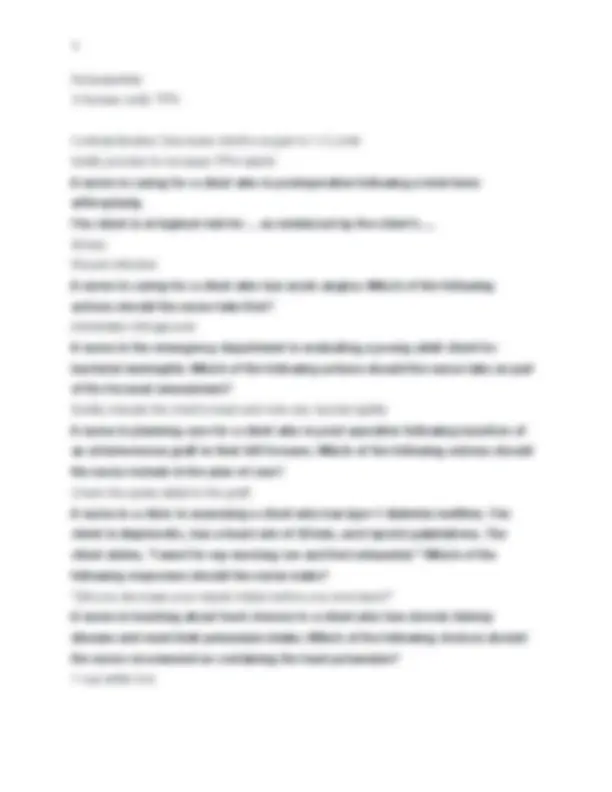
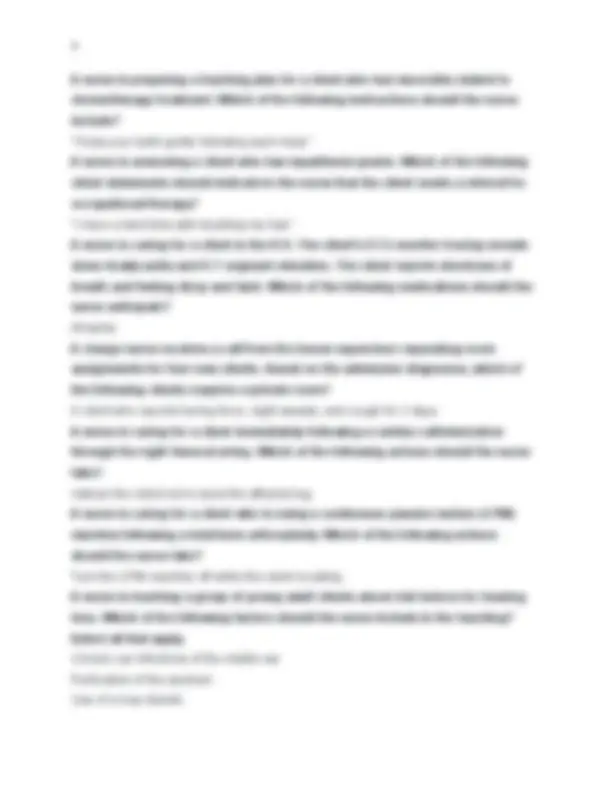
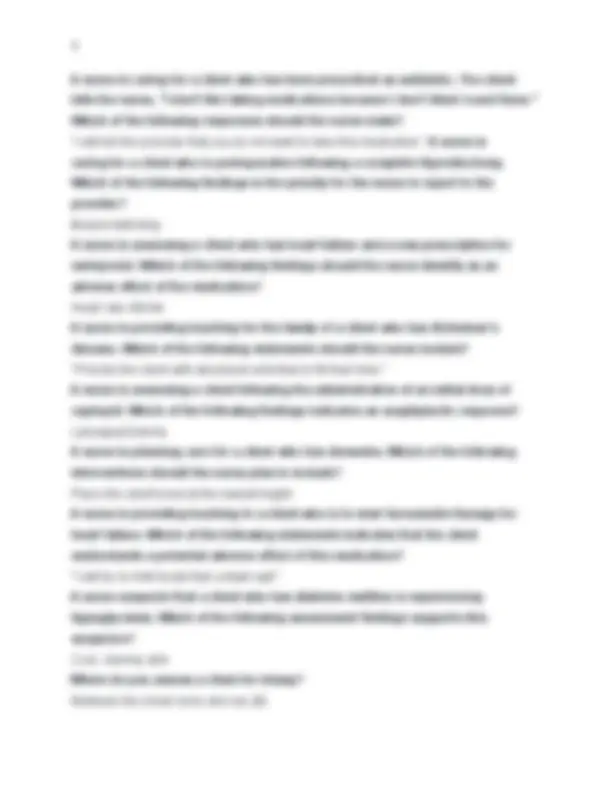
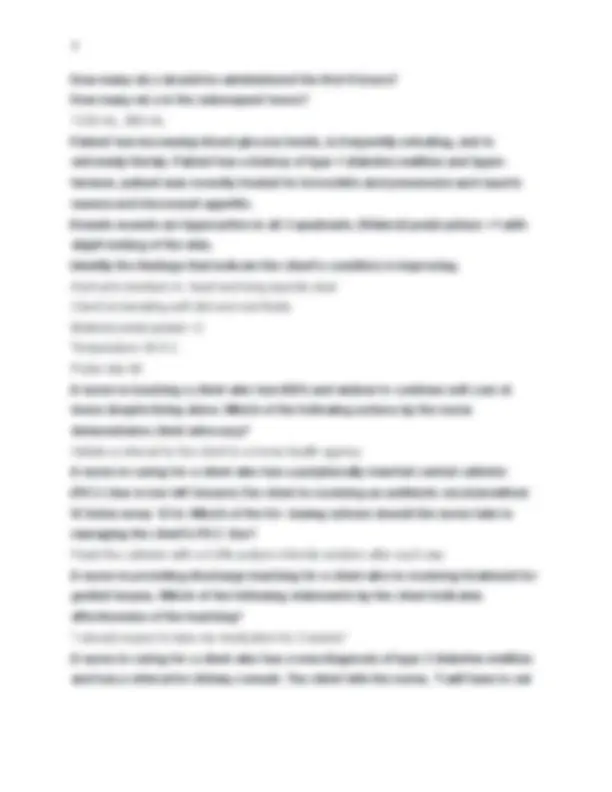
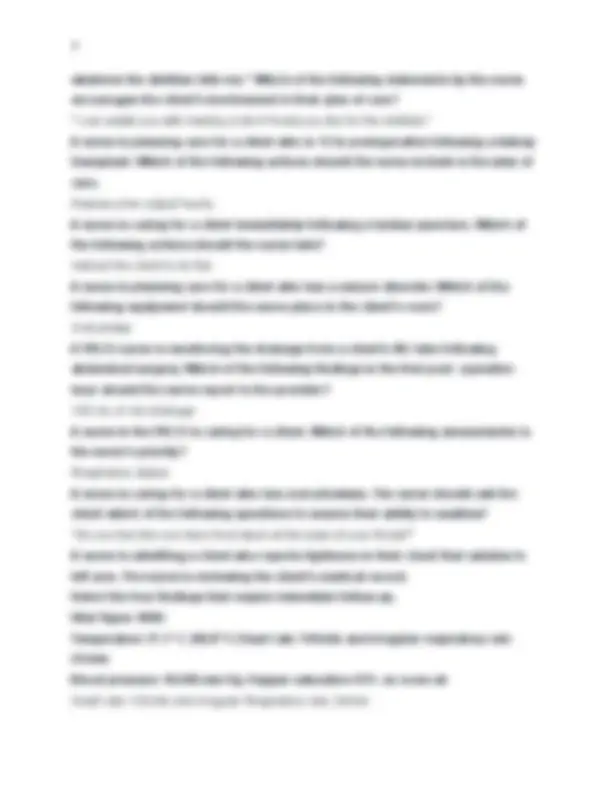
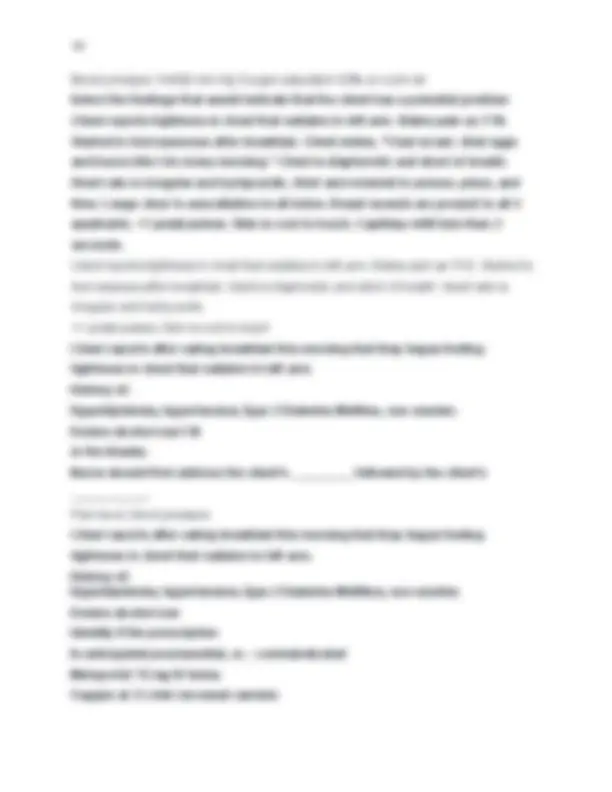
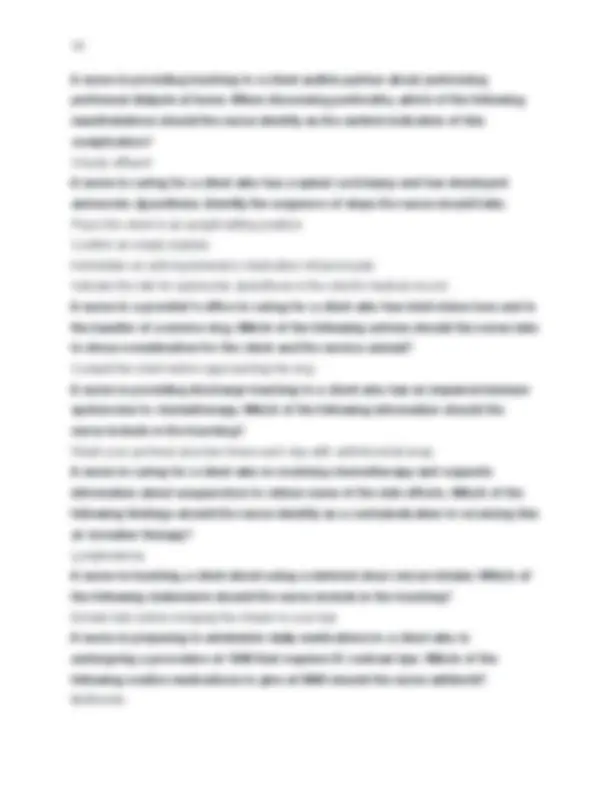
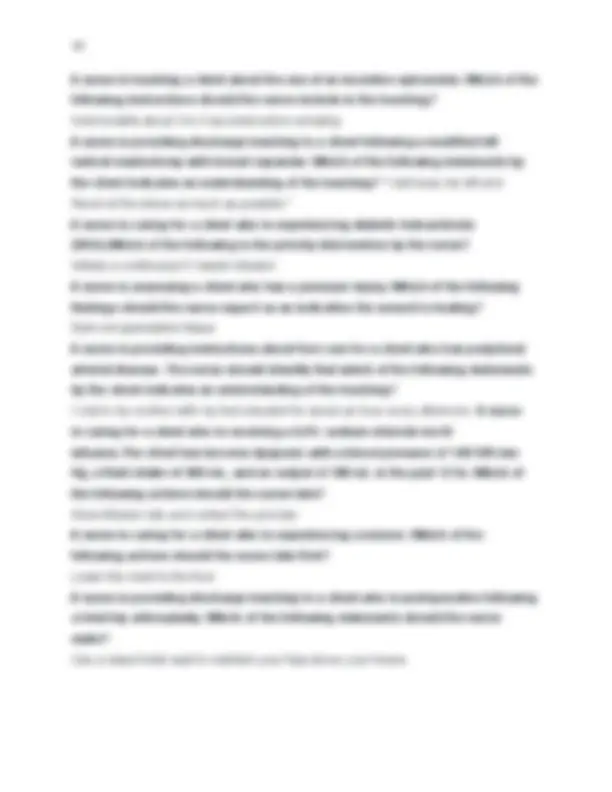
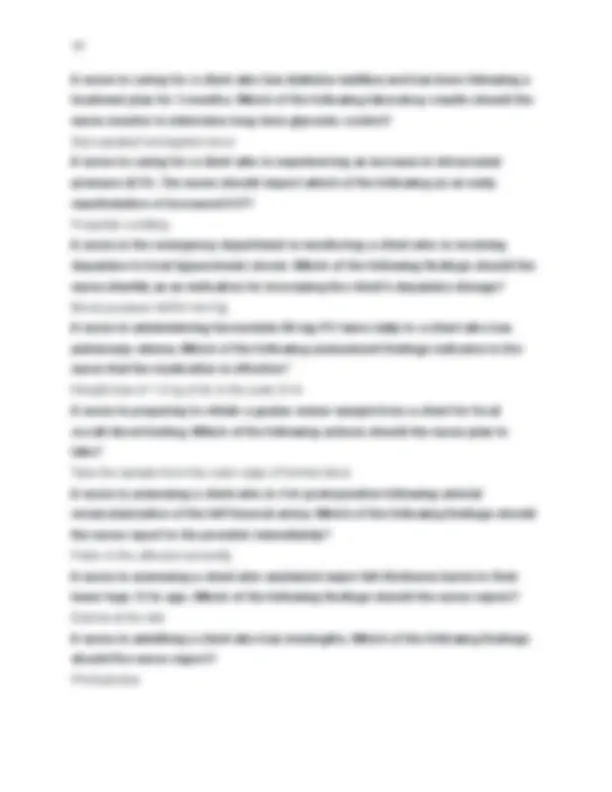


Study with the several resources on Docsity

Earn points by helping other students or get them with a premium plan


Prepare for your exams
Study with the several resources on Docsity

Earn points to download
Earn points by helping other students or get them with a premium plan
Community
Ask the community for help and clear up your study doubts
Discover the best universities in your country according to Docsity users
Free resources
Download our free guides on studying techniques, anxiety management strategies, and thesis advice from Docsity tutors
ADULT MEDICAL SURGICAL NGN PROCTORED EXAM ADULT MEDICAL SURGICAL ATI PROCTORED EXAM UPDATE| MEDICAL SURGICAL ATI PROCTORED ADULT EXAM 2025 LATEST UPDATE BRAND NEW!! A nurse is providing dietary instructions to a client who has cardiovascular disease. The nurse should identify that which of following statements by the client indicates an understanding of the teaching? "I will use canola oil when making salad dressing." A nurse is caring for a client who has COPD. Findings that require an immediate follow-up: Neurological - Client is oriented to person, place, and time. Client is restless. Pupils are reactive to light. Able to move all extremities. Pulmonary - Client is tachypneic, cough is productive, and mucous is yellow in color.Wheezes and crackles heard upon auscultation. Oxygen saturation 87% on room air. Cardiovascular - Pulse 110/min. +2 pulses in all extremities. Client is restless Tachypneic
Typology: Exams
1 / 17

This page cannot be seen from the preview
Don't miss anything!










A nurse is providing dietary instructions to a client who has cardiovascular disease. The nurse should identify that which of following statements by the client indicates an understanding of the teaching? "I will use canola oil when making salad dressing." A nurse is caring for a client who has COPD. Findings that require an immediate follow-up: Neurological - Client is oriented to person, place, and time. Client is restless. Pupils are reactive to light. Able to move all extremities. Pulmonary - Client is tachypneic, cough is productive, and mucous is yellow in color.Wheezes and crackles heard upon auscultation. Oxygen saturation 87% on room air. Cardiovascular - Pulse 110/min. +2 pulses in all extremities. Client is restless Tachypneic Cough is productive Mucous is yellow Pulse 110/min +2 pulses in all extremities A nurse is caring for a client who is experiencing an exacerbation of heart failure. The nurse is assessing the client 24 hr later. How should the nurse interpret the findings related to the diagnosis of heart failure? Specify whether the finding is unrelated to the diagnosis, a sign of potential improvement, or a sign of potential worsening condition. Diagnostic results: Hgb 8.4 g/dL (12 to 18g/dL) Hct 42% (37% to 47%) WBC count 9,800/mm3 (5,000 to 10,000/ mm3)
Potassium 4.32 mEq/L (3.5 to 5 mEq/L) Creatinine 0.9 mg/dL (0.5 to 1.2 mg/dL) Unrelated: Creatinine WBC Temperature Potential Improvement: Lung Sounds Potential worsening condition: Weight Shortness of breath with exertion A nurse is caring for a client who has heart failure. The client is at risk for developing _________ and_________. Dysrhythmias Acute Kidney Injury A nurse is providing teaching for a client who has diabetes mellitus about the self administration of insulin. The client has prescriptions for regular and NPH insulins. Which of the following statements by the client indicates an understanding of the teaching? "I will draw up the regular insulin into the syringe first." A nurse on a medical-surgical unit is planning care for a client who has dementia anda history of wandering. Which of the following actions should the nurse plan to implement? Use of a bed alarm. A nurse is caring for a client receiving TPN. Which of the following actions should the nurse take? Specify if the potential intervention is anticipated, nonessential, or contraindicated for the client. Anticipated: Request prescription for insulin Request an antibiotic to be administered Obtain client weight
A nurse is preparing a teaching plan for a client who has mucositis related to chemotherapy treatment. Which of the following instructions should the nurse include? "Floss your teeth gently following each meal." A nurse is assessing a client who has myasthenia gravis. Which of the following client statements should indicate to the nurse that the client needs a referral for occupational therapy? "I have a hard time with brushing my hair." A nurse is caring for a client in the ICU. The client's ECG monitor tracing reveals sinus bradycardia and S-T segment elevation. The client reports shortness of breath and feeling dizzy and faint. Which of the following medications should the nurse anticipate? Atropine A charge nurse receives a call from the house supervisor requesting room assignments for four new clients. Based on the admission diagnoses, which of the following clients requires a private room? A client who reports having fever, night sweats, and cough for 2 days A nurse is caring for a client immediately following a cardiac catheterization through the right femoral artery. Which of the following actions should the nurse take? Instruct the client not to bend the affected leg. A nurse is caring for a client who is using a continuous passive motion (CPM) machine following a total knee arthroplasty. Which of the following actions should the nurse take? Turn the CPM machine off while the client is eating. A nurse is teaching a group of young adult clients about risk factors for hearing loss. Which of the following factors should the nurse include in the teaching? Select all that apply. Chronic ear infections of the middle ear Perforation of the eardrum Use of a loop diuretic
A nurse is caring for a client who has been prescribed an antibiotic. The client tells the nurse, "I don't like taking medications because I don't think I need them." Which of the following responses should the nurse make? "I will tell the provider that you do not want to take this medication." A nurse is caring for a client who is postoperative following a complete thyroidectomy. Which of the following findings is the priority for the nurse to report to the provider? Muscle twitching A nurse is assessing a client who has heart failure and a new prescription for metoprolol. Which of the following findings should the nurse identify as an adverse effect of the medication? Heart rate 48/min A nurse is providing teaching for the family of a client who has Alzheimer's disease. Which of the following statements should the nurse include? "Provide the client with structured activities to fill their time." A nurse is assessing a client following the administration of an initial dose of captopril. Which of the following findings indicates an anaphylactic response? Laryngeal Edema A nurse is planning care for a client who has dementia. Which of the following interventions should the nurse plan to include? Place the client's bed at the lowest height. A nurse is providing teaching to a client who is to start furosemide therapy for heart failure. Which of the following statements indicates that the client understands a potential adverse effect of this medication? "I will try to limit foods that contain salt." A nurse suspects that a client who has diabetes mellitus is experiencing hypoglycemia. Which of the following assessment findings supports this suspicion? Cool, clammy skin Where do you assess a client for tetany? Between the cheek bone and ear (B)
A nurse is caring for a client in the emergency department. The nurse is caring for the client in the ED. The nurse understands that the client is at risk of developing which of the following complications? Select all that apply. Hypotension Cardiac Arrhythmias Renal Failure Cerebral Edema Patient has increasing blood glucose levels, is frequently urinating, and is extremely thirsty. Patient has a history of type 1 diabetes mellitus and hypertension; patient was recently treated for bronchitis and pneumonia and reports nausea and decreased appetite. Bowels sounds are hyperactive in all 4 quadrants. Bilateral pedal pulses +1 with slight tenting of the skin. Which of the following 3 provider prescriptions does the nurse anticipate? 0.9% sodium chloride at 15 ml/kg/hr for 1 hr and then reduce to 10 ml/kg/hr Blood glucose checks every 4 hr Insert indwelling urinary catheter Patient has increasing blood glucose levels, is frequently urinating, and is extremely thirsty. Patient has a history of type 1 diabetes mellitus and hyper- tension; patient was recently treated for bronchitis and pneumonia and reports nausea and decreased appetite. Bowels sounds are hyperactive in all 4 quadrants. Bilateral pedal pulses +1 with slight tenting of the skin. The nurse should plan to first administer _____________ followed by _____________. Fluids; Patient has increasing blood glucose levels, is frequently urinating, and is extremely thirsty. Patient has a history of type 1 diabetes mellitus and hyper- tension; patient was recently treated for bronchitis and pneumonia and reports nausea and decreased appetite. Bowels sounds are hyperactive in all 4 quadrants. Bilateral pedal pulses +1 with slight tenting of the skin.
How many mLs should be administered the first 8 hours? How many mLs in the subsequent hours? 1320 mL, 880 mL Patient has increasing blood glucose levels, is frequently urinating, and is extremely thirsty. Patient has a history of type 1 diabetes mellitus and hyper- tension; patient was recently treated for bronchitis and pneumonia and reports nausea and decreased appetite. Bowels sounds are hyperactive in all 4 quadrants. Bilateral pedal pulses +1 with slight tenting of the skin. Identify the findings that indicate the client's condition is improving. Alert and oriented x4, heart and lung sounds clear Client is tolerating soft diet and oral fluids Bilateral pedal pulses + Temperature 36.8 C Pulse rate 84 A nurse is teaching a client who has AIDS and wishes to continue self-care at home despite living alone. Which of the following actions by the nurse demonstrates client advocacy? Initiate a referral for the client to a home health agency. A nurse is caring for a client who has a peripherally inserted central catheter (PICC) line in her left forearm.The client is receiving an antibiotic via intermittent IV bolus every 12 hr. Which of the fol- lowing actions should the nurse take in managing the client's PICC line? Flush the catheter with a 0.9% sodium chloride solution after each use A nurse is providing discharge teaching for a client who is receiving treatment for genital herpes. Which of the following statements by the client indicates effectiveness of the teaching? "I should expect to take my medication for 3 weeks." A nurse is caring for a client who has a new diagnosis of type 2 diabetes mellitus and has a referral for dietary consult. The client tells the nurse, "I will have to eat
Blood pressure 164/80 mm Hg Oxygen saturation 93% on room air Select the findings that would indicate that the client has a potential problem Client reports tightness in chest that radiates to left arm. States pain as 7/10. Started to feel nauseous after breakfast. Client states, "I had scram- bled eggs and bacon like I do every morning." Client is diaphoretic and short of breath. Heart rate is irregular and tachycardic. Alert and oriented to person, place, and time. Lungs clear to auscultation in all lobes. Bowel sounds are present in all 4 quadrants. +1 pedal pulses. Skin is cool to touch. Capillary refill less than 2 seconds. Client reports tightness in chest that radiates to left arm. States pain as 7/10. Started to feel naseous after breakfast. Client is diaphoretic and short of breath. Heart rate is irregular and tachycardic. +1 pedal pulses. Skin is cool to touch Client reports after eating breakfast this morning that they began feeling tightness in chest that radiates to left arm. History of: Hyperlipidemia, hypertension,Type 2 Diabetes Mellitus, non smoker. Denies alcohol use Fill in the blanks: Nurse should first address the client's _________ followed by the client's ___________. Pain level; blood pressure Client reports after eating breakfast this morning that they began feeling tightness in chest that radiates to left arm. History of: Hyperlipidemia, hypertension,Type 2 Diabetes Melllitus, non smoker. Denies alcohol use Identify if the prescription fs anticipated,nonessential, or. : contraindicated Metoprolol 15 mg IV bolus Oxygen at 2 L/min via nasal cannula
Draw electrolytes along with Hgb and Hct Morphine 6 mg IV bolus every 3 hr as needed for pain Nitroglycerin 0.5 mg SL now may repeat every 5 mins up to 3 doses Daily weifht: Obtain daily weight Atropine 0.5 mg IV bolus every 5 min up to 2 mg if heart rate drops below 60 lient reports after eating breakfast this morning that they began feeling tightness in chest that radiates to left arm. History of: Hyperlipidemia, hypertension,Type 2 Diabetes Mellitus, non smoker. Denies alcohol use A nurse is reviewing the client's diagnostic results and vital signs. Which of the following actions should the nurse take? Anticipate client to be prepped for cardiac cath? Assist with a continuous heparin infusion Encourage the client to ambulate Anticipate an increased dosage of metoprolol Obtain a prescription for client to be NPO Request a prescription for an antibiotic Client reports after eating breakfast this morning that they began feeling tightness in chest that radiates to left arm. Which of the following findings indicate the client's condition has improved? Pain level Respiratory rate A nurse is caring for a client who has acute heart failure and received morphine IV 30 min ago. Which of the following findings should the nurse identify as an indication that the medication was effective? Decreased anxiety A nurse is monitoring an older adult client who has an exacerbation of chronic lymphocytic leukemia. The nurse notes petechiae on the client's skin. Which of the following actions should the nurse take? Institute bleeding precautions A nurse is caring for a client who has emphysema. Which of the following interventions should the nurse include in the client's plan of care?
A nurse is providing teaching to a client andhis partner about performing peritoneal dialysis at home. When discussing peritonitis, which of the following manifestations should the nurse identify as the earliest indication of this complication? Cloudy effluent A nurse is caring for a client who has a spinal cord injury and has developed autonomic dysreflexia. Identify the sequence of steps the nurse should take. Place the client in an upright sitting position Confirm an empty bladder Administer an anti-hypertensive medication intravenously Indicate the risk for autonomic dysreflexia in the client's medical record A nurse in a provider's office is caring for a client who has total vision loss and is the handler of a service dog. Which of the following actions should the nurse take to show consideration for the client and the service animal? Consult the client before approaching the dog A nurse is providing discharge teaching to a client who has an impaired immune system due to chemotherapy. Which of the following information should the nurse include in the teaching? Wash your perineal area two times each day with antimicrobial soap. A nurse is caring for a client who is receiving chemotherapy and requests information about acupuncture to relieve some of the side effects. Which of the following findings should the nurse identify as a contraindication to receiving this al- ternative therapy? Lymphedema A nurse is teaching a client about using a metered-dose rescue inhaler. Which of the following statements should the nurse include in the teaching? Exhale fully before bringing the inhaler to your lips A nurse is preparing to administer daily medications to a client who is undergoing a procedure at 1000 that requires IV contrast dye. Which of the following routine medications to give at 0800 should the nurse withhold? Metformin
A nurse is teaching a client about the use of an incentive spirometer. Which of the following instructions should the nurse include in the teaching? Hold breaths about 3 to 5 seconds before exhaling A nurse is providing discharge teaching to a client following a modified left radical mastectomy with breast expander. Which of the following statements by the client indicates an understanding of the teaching? "I will keep my left arm flexed at the elbow as much as possible." A nurse is caring for a client who is experiencing diabetic ketoacidosis (DKA).Which of the following is the priority intervention by the nurse? Initiate a continuous IV insulin infusion A nurse is assessing a client who has a pressure injury. Which of the following findings should the nurse expect as an indication the wound is healing? Dark red granulation tissue A nurse is providing instructions about foot care for a client who has peripheral arterial disease. The nurse should identify that which of the following statements by the client indicates an understanding of the teaching? I rest in my recliner with my feet elevated for about an hour every afternoon. A nurse is caring for a client who is receiving a 0.9% sodium chloride via IV infusion.The client has become dyspneic with a blood pressure of 140/100 mm Hg, a fluid intake of 960 mL, and an output of 300 mL in the past 12 hr. Which of the following actions should the nurse take? Slow infusion rate and contact the provider A nurse is caring for a client who is experiencing a seizure. Which of the following actions should the nurse take first? Lower the client to the floor A nurse is providing discharge teaching to a client who is postoperative following a total hip arthroplasty. Which of the following statements should the nurse make? Use a raised toilet seat to maintain your hips above your knees
A nurse is caring for a client who has a contusion of the brainstem and reports thirst.The client's urinary output was 4,000 mL over the past 24 hr. The nurse should anticipate a prescription for which of the following IV medications? Desmopressin A nurse is reviewing the medical record of a client who has acute gout.The nurse should expect an increase in which of the following laboratory results? Uric acid A nurse is caring for a client who has skeletal traction applied to the left leg. Which of the following actions should the nurse take? Provide the client with a trapeze bar A nurse is assessing a client who has increased intracranial pressure. The nurse should recognize that which of the following is the first sign of dete- riorating neurological status? Altered level of consciousness A nurse is teaching a client who has Graves' disease about recognizing the manifestations of thyroid storm. Which of the following findings should the nurse include in the teaching? Increased temperature A nurse is caring for a client who has a chest tube.The client asks why the fluid in the water-seal chamber rises and falls. Which of the following statements should the nurse make? Your breathing pattern causes this. A nurse is caring for a group of clients who are 12 hr postoperative. The nurse should identify that the client who had which of the following procedures is at risk for developing fat embolism syndrome? Internal fixation of a fractured hip A nurse manager is providing an in-service to a group of newly licensed nurses about the use of personal protective equipment. Which of the following statements by a newly licensed nurse indicates an understanding of the teaching? "should wear goggles when irrigating a wound."
The client is at risk for developing ____________ due to ________________. Infection; white blood cell count